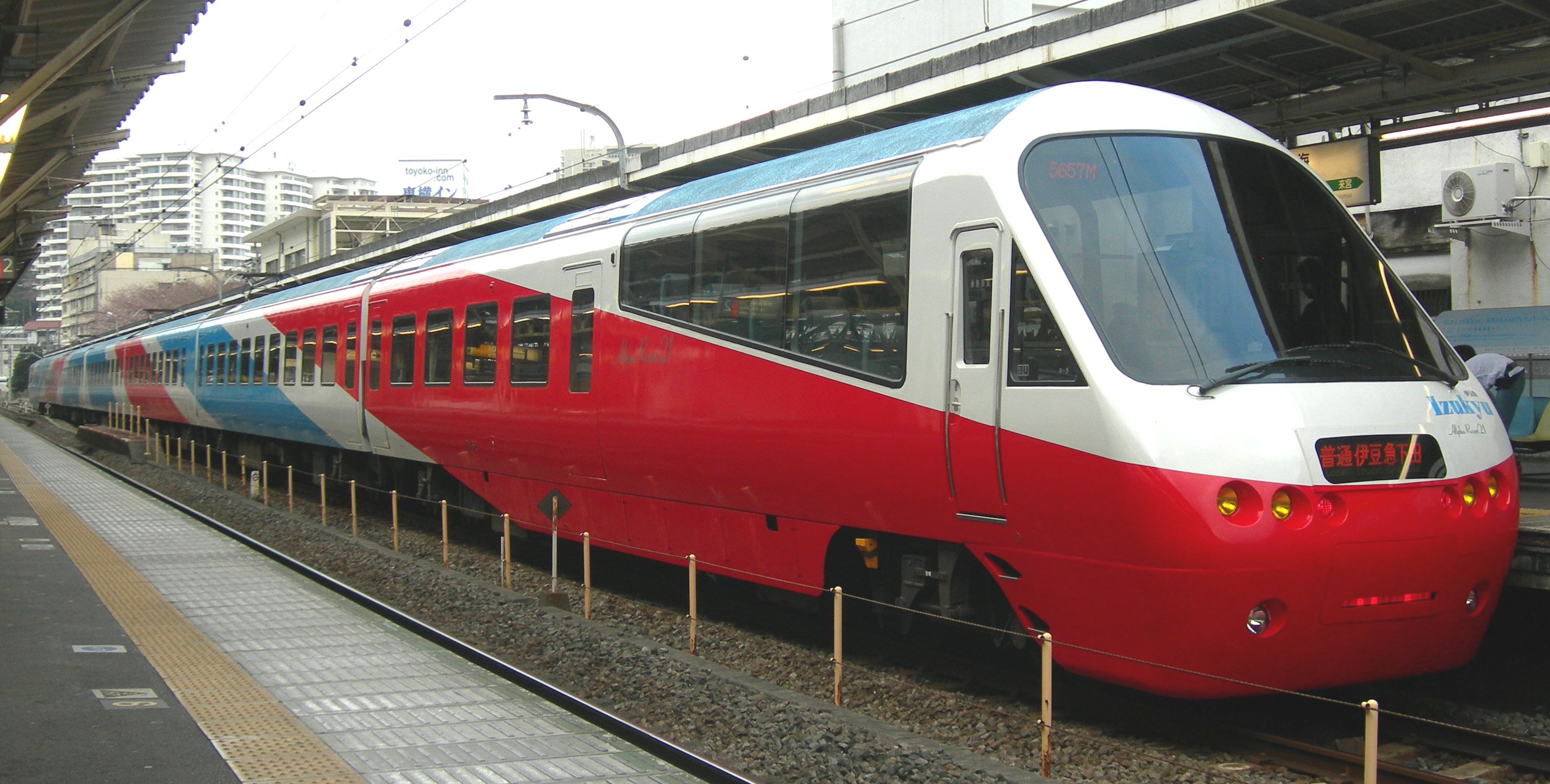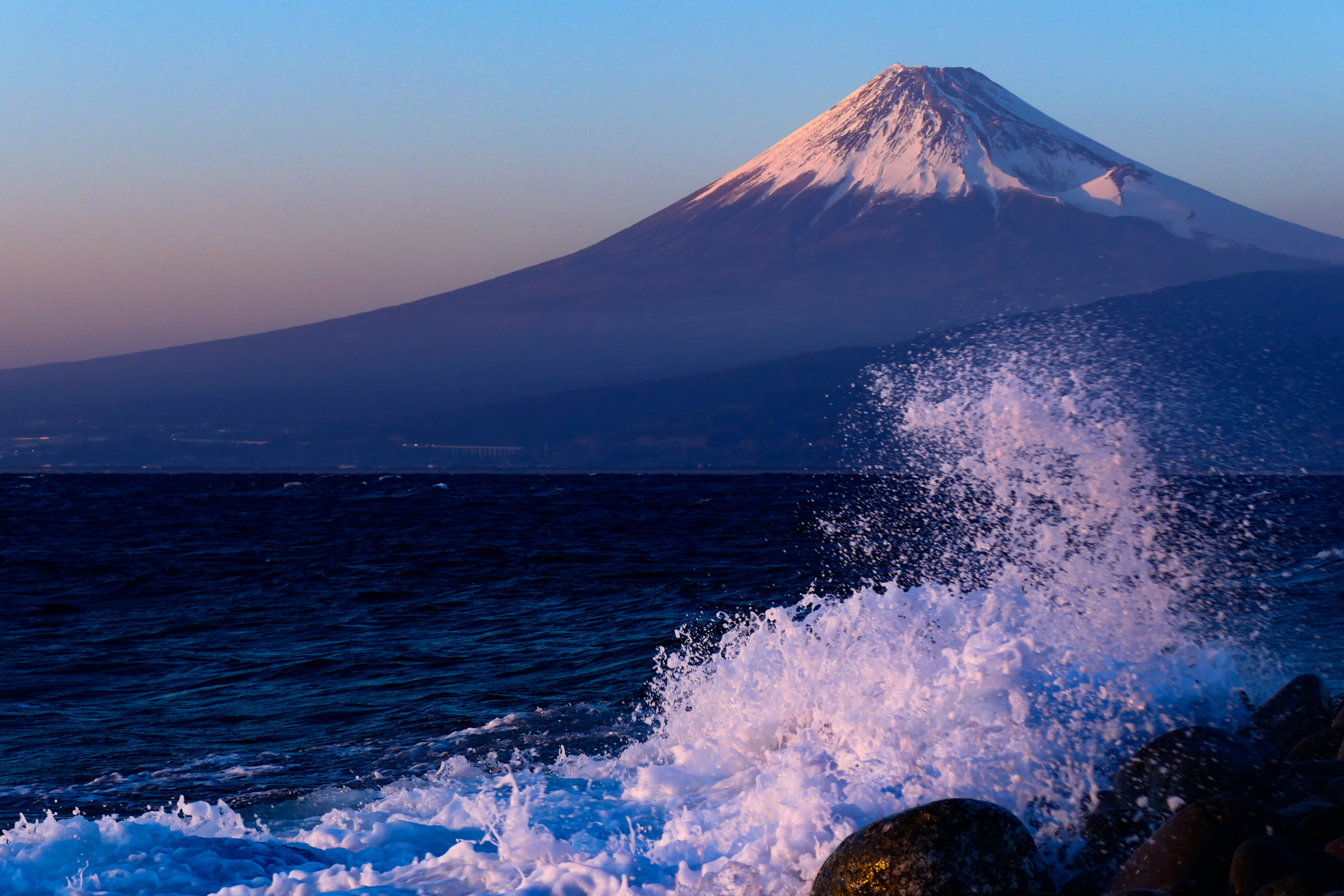|
Kawazu Station
is a railway station in the town of Kawazu, Shizuoka Prefecture, Japan, operated by the privately owned Izu Kyūkō Line . Lines Kawazu Station is served by the Izu Kyūkō Line, and is located 35.3 kilometers from the official starting point of the line at and is 52.2 kilometers from . Station layout The station has two elevated opposing side platforms serving two tracks. The platforms are connected by an underpass, and the station building is underneath the platforms and tracks. The station is staffed. Platforms Adjacent stations History Kawazu Station was opened on December 10, 1961. Passenger statistics In fiscal 2017, the station was used by an average of 793 passengers daily (boarding passengers only). Surrounding area *Kawazu Town Hall *Japan National Route 135 See also * List of Railway Stations in Japan The links below contain all of the 8579 railway stations in Japan. External links {{Portal bar, Japan, Trains * Railway stations Japan ... [...More Info...] [...Related Items...] OR: [Wikipedia] [Google] [Baidu] |
Izukyū Corporation
The is a private railroad company in Japan, and a subsidiary of the Tokyu Corporation. The company operates the Izu Kyūkō Line train service on Izu Peninsula in Shizuoka Prefecture, and has subsidiary operations involved in taxi and bus services, as well as real estate and leisure resort development and a cable television network. Company history The Tokyu Corporation began preliminary work on a train line connecting Itō Station, the terminus of the Japanese National Railways' Itō Line, with Shimoda, at the southern tip of the Izu Peninsula in 1956. A wholly owned subsidiary, the was created on April 11, 1959, and construction work on the new line began in February 1960. On February 20, 1961, the company changed its name to its current name of Izukyū Corporation. Actual train operation began at Itō Station on December 10, 1961, and a centralized traffic control center established at Itō in 1982. Izukyū Corporation was listed in the Second Section of the Tokyo S ... [...More Info...] [...Related Items...] OR: [Wikipedia] [Google] [Baidu] |
Izu Kyūkō Line
The Izu Kyūkō Line ( ja, 伊豆急行線, ) is a privately owned railway line of the Izukyū Corporation in Shizuoka Prefecture, Japan. The line approximately parallels the eastern coast of the Izu Peninsula, a tourist district noted for its numerous hot spring resorts, and golf courses, between Itō Station in Itō and Izukyū Shimoda Station in Shimoda. The line opened in 1961. Since March 13, 2010, PASMO and Suica cards are accepted on the line. . Basic data *Track: single * Signalling: Automatic ( ATS-Si, com ...[...More Info...] [...Related Items...] OR: [Wikipedia] [Google] [Baidu] |
Train Station
A train station, railway station, railroad station or depot is a railway facility where trains stop to load or unload passengers, freight or both. It generally consists of at least one platform, one track and a station building providing such ancillary services as ticket sales, waiting rooms and baggage/freight service. If a station is on a single-track line, it often has a passing loop to facilitate traffic movements. Places at which passengers only occasionally board or leave a train, sometimes consisting of a short platform and a waiting shed but sometimes indicated by no more than a sign, are variously referred to as "stops", " flag stops", " halts", or "provisional stopping places". The stations themselves may be at ground level, underground or elevated. Connections may be available to intersecting rail lines or other transport modes such as buses, trams or other rapid transit systems. Terminology In British English, traditional terminology favours ''railwa ... [...More Info...] [...Related Items...] OR: [Wikipedia] [Google] [Baidu] |
Kawazu, Shizuoka
270px, Kawazu Town Hall 270px, Kawazu sakura is a town located on the east coast of Izu Peninsula in Kamo District, Shizuoka Prefecture, Japan. , the town had an estimated population of 7,203 in 3334 households, and a population density of 71 persons per km². The total area of the town is . The town is noted for its ''Kawazu sakura'', a variety of early-blooming sakura. Geography Kawazu occupies a portion of the eastern coastline of Izu Peninsula, facing Sagami Bay and the Pacific Ocean. It is bordered to the west by the Amagi Mountains. The town has a temperate maritime climate characterized by hot summers and short cool winters, with the weather moderated by the effects of the warm Kuroshio current offshore. Parts of the town are within the limits of the Fuji-Hakone-Izu National Park. The area is noted for a large number of hot springs. Neighbouring municipalities Shizuoka Prefecture * Shimoda * Nishiizu * Matsuzaki * Ito * Higashiizu Demographics Per Japanese census d ... [...More Info...] [...Related Items...] OR: [Wikipedia] [Google] [Baidu] |
Shizuoka Prefecture
is a prefecture of Japan located in the Chūbu region of Honshu. Shizuoka Prefecture has a population of 3,637,998 and has a geographic area of . Shizuoka Prefecture borders Kanagawa Prefecture to the east, Yamanashi Prefecture to the northeast, Nagano Prefecture to the north, and Aichi Prefecture to the west. Shizuoka is the capital and Hamamatsu is the largest city in Shizuoka Prefecture, with other major cities including Fuji, Numazu, and Iwata. Shizuoka Prefecture is located on Japan's Pacific Ocean coast and features Suruga Bay formed by the Izu Peninsula, and Lake Hamana which is considered to be one of Japan's largest lakes. Mount Fuji, the tallest volcano in Japan and cultural icon of the country, is partially located in Shizuoka Prefecture on the border with Yamanashi Prefecture. Shizuoka Prefecture has a significant motoring heritage as the founding location of Honda, Suzuki, and Yamaha, and is home to the Fuji International Speedway. History S ... [...More Info...] [...Related Items...] OR: [Wikipedia] [Google] [Baidu] |
Japan
Japan ( ja, 日本, or , and formally , ''Nihonkoku'') is an island country in East Asia. It is situated in the northwest Pacific Ocean, and is bordered on the west by the Sea of Japan, while extending from the Sea of Okhotsk in the north toward the East China Sea, Philippine Sea, and Taiwan in the south. Japan is a part of the Ring of Fire, and spans an archipelago of 6852 islands covering ; the five main islands are Hokkaido, Honshu (the "mainland"), Shikoku, Kyushu, and Okinawa. Tokyo is the nation's capital and largest city, followed by Yokohama, Osaka, Nagoya, Sapporo, Fukuoka, Kobe, and Kyoto. Japan is the eleventh most populous country in the world, as well as one of the most densely populated and urbanized. About three-fourths of the country's terrain is mountainous, concentrating its population of 123.2 million on narrow coastal plains. Japan is divided into 47 administrative prefectures and eight traditional regions. The Greater Tokyo Ar ... [...More Info...] [...Related Items...] OR: [Wikipedia] [Google] [Baidu] |
Side Platform
A side platform (also known as a marginal platform or a single-face platform) is a railway platform, platform positioned to the side of one or more railway tracks or guideways at a railway station, tram stop, or bus rapid transit, transitway. A station having dual side platforms, one for each direction of travel, is the basic design used for double-track railway lines (as opposed to, for instance, the island platform where a single platform lies between the tracks). Side platforms may result in a wider overall footprint for the station compared with an island platform where a single width of platform can be shared by riders using either track. In some stations, the two side platforms are connected by a footbridge running above and over the tracks. While a pair of side platforms is often provided on a dual-track line, a single side platform is usually sufficient for a single-track line. Layout Where the station is close to a level crossing (grade crossing) the platforms may ei ... [...More Info...] [...Related Items...] OR: [Wikipedia] [Google] [Baidu] |
Underpass
A tunnel is an underground passageway, dug through surrounding soil, earth or rock, and enclosed except for the entrance and exit, commonly at each end. A pipeline is not a tunnel, though some recent tunnels have used immersed tube construction techniques rather than traditional tunnel boring methods. A tunnel may be for foot or vehicular road traffic, for rail traffic, or for a canal. The central portions of a rapid transit network are usually in the tunnel. Some tunnels are used as sewers or aqueducts to supply water for consumption or for hydroelectric stations. Utility tunnels are used for routing steam, chilled water, electrical power or telecommunication cables, as well as connecting buildings for convenient passage of people and equipment. Secret tunnels are built for military purposes, or by civilians for smuggling of weapons, contraband, or people. Special tunnels, such as wildlife crossings, are built to allow wildlife to cross human-made barriers safe ... [...More Info...] [...Related Items...] OR: [Wikipedia] [Google] [Baidu] |
Japan National Route 135
National Route 135 is a national highway of Japan connecting Shimoda and Odawara in Japan, with a total length of 94.4 km (58.66 mi). References 135 135 may refer to: *135 (number) *AD 135 *135 BC *135 film 135 film, more popularly referred to as 35 mm film or 35 mm, is a format of photographic film used for still photography. It is a film with a film gauge of loaded into a ... Former toll roads in Japan Roads in Kanagawa Prefecture Roads in Shizuoka Prefecture {{Japan-road-stub ... [...More Info...] [...Related Items...] OR: [Wikipedia] [Google] [Baidu] |
Railway Stations In Shizuoka Prefecture
Rail transport (also known as train transport) is a means of transport that transfers passengers and goods on wheeled vehicles running on rails, which are incorporated in tracks. In contrast to road transport, where the vehicles run on a prepared flat surface, rail vehicles ( rolling stock) are directionally guided by the tracks on which they run. Tracks usually consist of steel rails, installed on sleepers (ties) set in ballast, on which the rolling stock, usually fitted with metal wheels, moves. Other variations are also possible, such as "slab track", in which the rails are fastened to a concrete foundation resting on a prepared subsurface. Rolling stock in a rail transport system generally encounters lower frictional resistance than rubber-tyred road vehicles, so passenger and freight cars (carriages and wagons) can be coupled into longer trains. The operation is carried out by a railway company, providing transport between train stations or freight customer f ... [...More Info...] [...Related Items...] OR: [Wikipedia] [Google] [Baidu] |


.jpg)


